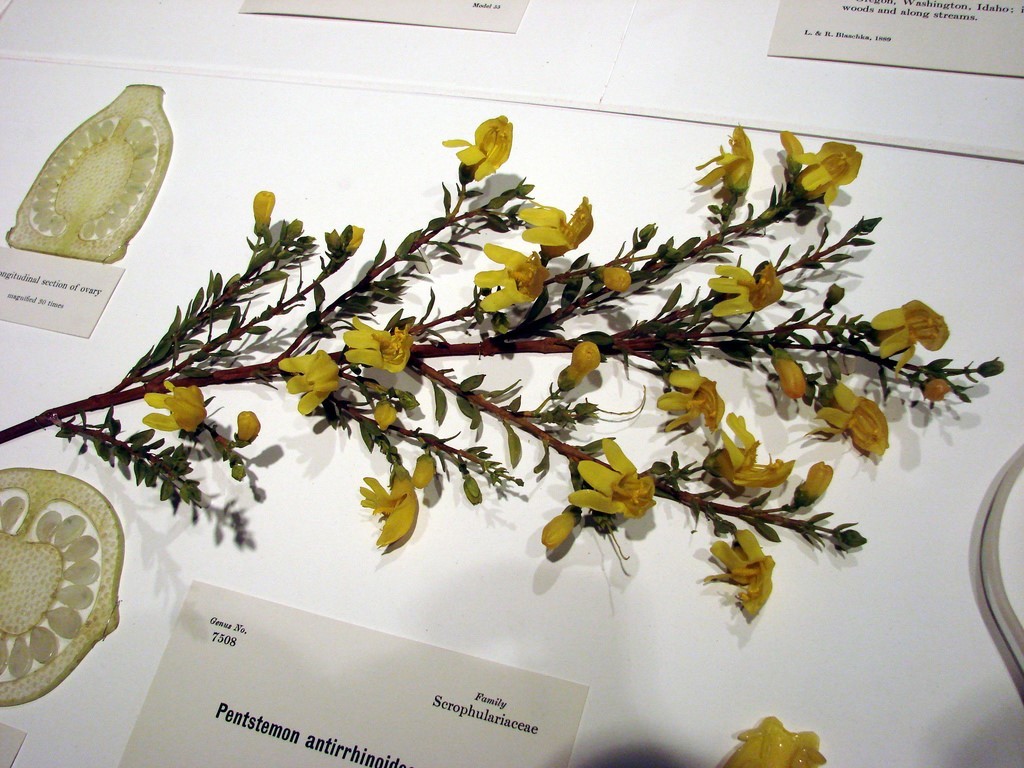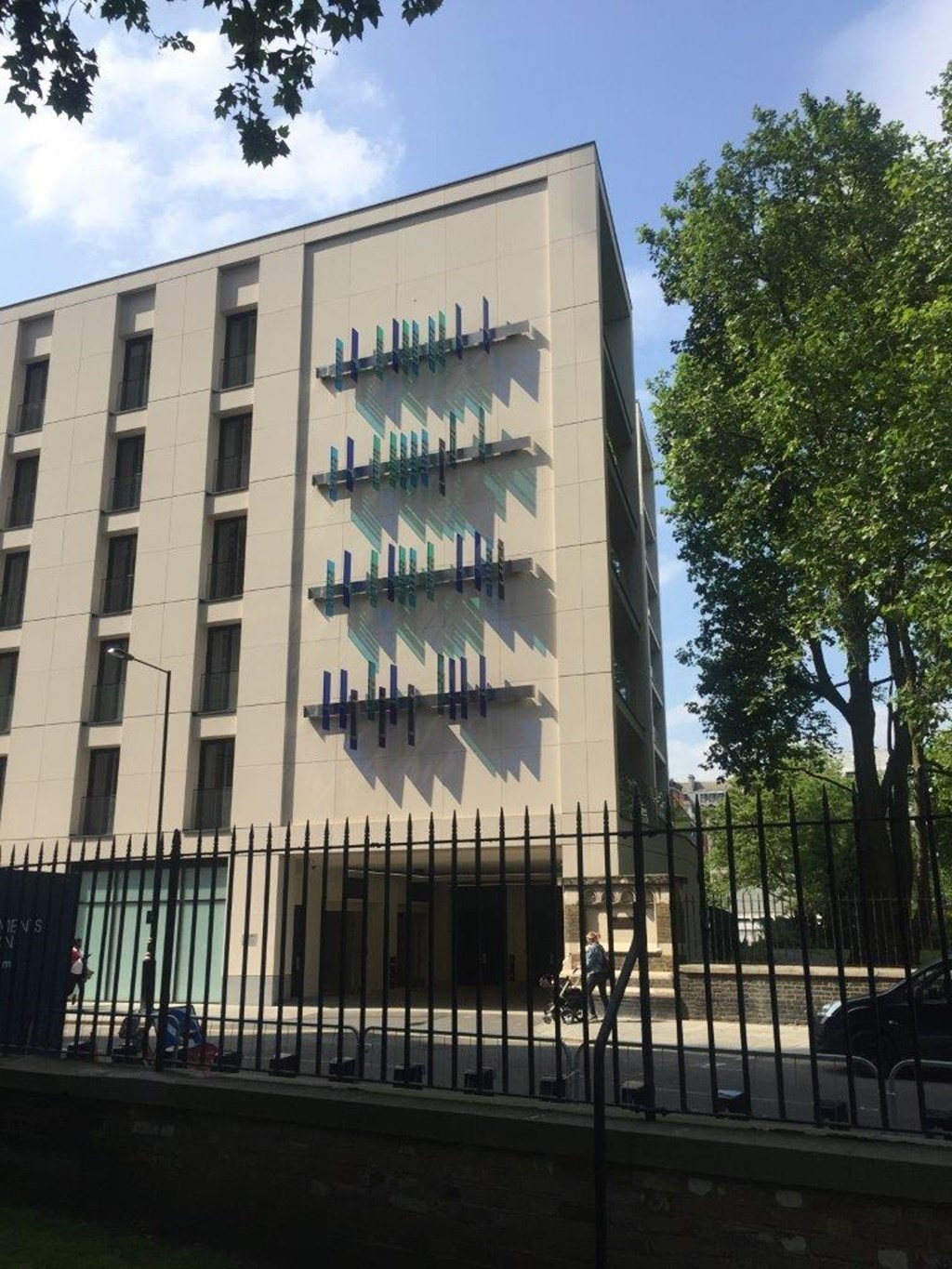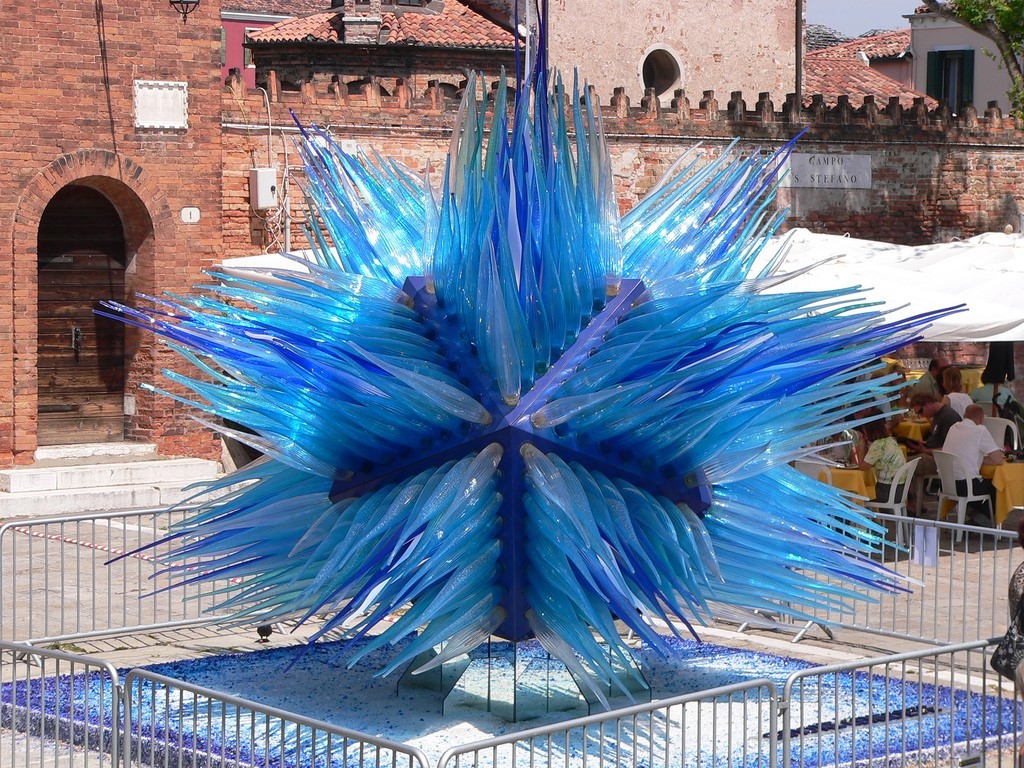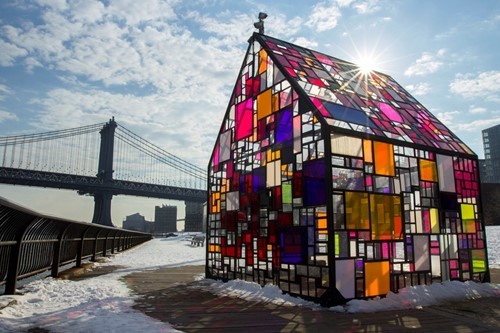
For thousands of years, people have been using glass to make art. The works have ranged from small objects that can be displayed and admired in the home to large monuments that often fill large public spaces.
Glass is often used in art because it is most likely down to the numerous benefits it carries as a crafting material. Not only does it offer many beautiful ways to capture and reflect light, but it is also incredibly malleable, with the capacity to take on different shapes and colours to the artist’s liking. In addition, finishes can be applied to glass to create different effects, such as bevelling, etching, cracking, and many more. These qualities have made it a popular choice for artisans throughout history, right up to the present day.
You probably don’t have to travel far to see one of the most widespread examples of this art. One of the earliest techniques used to create decorative glass was staining, where additives were used at the molten stage to colour the finished product. Take a stroll along a street in your local town or city, and there is a strong possibility that you will see a stained-glass window, as part of a church or in the windows of someone’s home.
Stained glass windows are just one example of the magnificent glass art all around us. If you know where and what to look for, you might just see something that is astounding. With this in mind, let’s take a closer look at some of the world’s most amazing glass artworks and where you can find them.
Fiori di Como by Dale Chihuly
Created in 1998, prolific artist Dale Chihuly’s Fiori di Como is the world’s largest glass sculpture. The installation resides inside the lobby of the world-famous Bellagio Hotel in Las Vegas, and is comprised of around 2,000 glass umbrellas that cover 190 square metres across the giant room’s ceiling. The installation reaches over three metres in depth and is mounted on a steel frame to keep it in its prominent position as the centrepiece of the room.
Over one hundred specialists worked under the direction of Chihuly to create this piece of glass art, including glass blowers, engineers, and architects. Two decades since its unveiling, it continues to wow visitors with its dazzling explosion of light and colour. This is something the artist himself emphasised in an interview about the piece: “Colour is one of the great properties of glass and is more intense in glass than any other material…I made the colour appear random, yet organized as you might find in nature.”
Stained glass windows of Sainte-Chapelle

Sainte-Chapelle is one of the best preserved medieval wonders in Europe, and its windows are completely out of this world. The chapel was located at the heart of the Palais de la Cité, the old royal palace and residence of the kings and queens of France, but the area was rebuilt as the Palais de Justice in later years. It was constructed over seven years in the 1240s, with special emphasis placed on the glass windows, which are undoubtedly the centrepiece.
While the 600 square metres of stained glass are certainly beautiful, they were originally designed to tell biblical, local, and political stories, especially to those who could not read. There are 1,130 biblical figures depicted in the glass, spread over 15 huge windows and one large rose window. The Saint-Chapelle glass has been damaged over the years by both neglect, disaster, and conflict, but they have also undergone multiple restorations, the most recent being completed in 2015. The chapel now has an outside ‘glass skin’ over each window that protects them without altering their appearance.
Glass flowers collection at Harvard Museum of Natural History

Where: Harvard Museum of Natural History, Cambridge, Massachusetts
The Ware Collection of Blaschka Glass Models of Plants, to give it its full title, is a set of over 4,000 sculpted glass flowers that is displayed at the Harvard Museum of Natural History. To browse this collection is to see one of the most amazing uses of glass art for scientific purposes, with over 830 plant species accurately represented. The glass flowers were created by a father and son team of German artists, Leopold and Rudolf Blaschka, in the years stretching from 1887 to 1936.
They were produced at the request of a professor, George Lincoln Goodale, who wished to teach students about the anatomy of certain species all year round, without having to rely on natural specimens. They are made from glass and supported by wire — many parts were shaped after being softened by heat, while some were blown. To capture the life-like shades of real plants, coloured glass was used from the start in some cases, whereas others were ‘cold-painted’ with a thin layer of ground, coloured glass or metal oxides warmed until they fused to the sculpture. The real beauty of these glass flowers is that they are always in bloom, so visitors can enjoy their beauty all year round.
The Sun by Dale Chihuly

Where: The Montreal Museum of Fine Arts
The Sun is the second artwork by Dale Chihuly to feature here, and rightly so. Resembling a tree-sunburst hybrid, the installation consists of over 1,300 hand glass-blown elements that are expertly woven together to form a coherent whole. The piece comes alive in a darkened space indoors or in the evening outdoors, when light is shone through it to produce a breathtaking spectacle of bold colour. About the piece, the artist himself said: “What makes The Sun work for me is the massing of colour. If you take a thousand hand-blown pieces of a colour, put them together and then shoot light through them, it’s going to be something to look at.”
This iconic piece has captured the imagination of so many people that it embarked on a world tour after it was created, showing at many prestigious museums and gardens along the way. At home indoors or outdoors, the installation has found temporary homes at places like the New York Botanical Gardens (2006), the de Young Museum in San Francisco (2008), and Berkeley Square in London (2014). It eventually found a permanent home at the Montreal Museum of Fine Arts.
Singing on Paddington Street by Julia Vogl

Where: Paddington Street, London, UK
Singing on Paddington Street is a truly unique work by renowned international artist Julia Vogl that celebrates the gift of song in the centre of London. The 102 metre square sculpture has 42 individual sections made with coloured glass, with each panel representing a musical note on the key. The artwork is a significant tribute to the area of Marylebone that was a popular haunt for recording artists in the 1960s and 1970s. The whole installation makes up a popular song, which people able to read music might be able to recognise.
Here at Dellner Glass, we supplied the laminated glass panels for each section of this project. Each piece is made with complex interlayers, one of which is made from Vanceva, which gives the panes their attractive blue-green shading. In addition to this, the glass was prepared using state-of-the-art computer-controlled waterjet cutting tables, drills, grinders and polishers. The real beauty of Singing on Paddington Street is that it is a piece of glass art that can be enjoyed by anyone, from a music lover to someone who is just passing by.
Comet Glass Star by Simone Cenedese

Where: Campo San Stefano, Murano, Venice, Italy
Murano in Venice is the glass-making capital of the world, and it seems only fitting that one of the main squares is the home of a beautiful creation like Comet Glass Star. The island became home to the city’s glassmakers when they were relocated in 1291 due to the risk of fire, and has produced world-famous glass art ever since. This futuristic-looking piece sits on the Campo San Stefano beneath the 19th-century clock tower, offering a startling juxtaposition of the old and the new.
The sculpture was created by celebrated Venetian artist Simone Cenedese to mark Christmas in 2007. It is made with 500 blown-glass elements that come in six colors and a range of different sizes — the result is a jagged shape that seems almost inspired by natural ice formations. When lit in the evenings, the Comet Glass Star shines eerily with a radiant blue glow thanks to its glass colouring.
Kolonihavehus by Tom Fruin

Where: Touring exhibit, last shown at Brooklyn Bridge Park, Brooklyn, USA
Not all glass artworks have to be created from scratch, and Brooklyn-based artist Tom Fruin’s Kolonihavehus is proof that you don’t need to have bespoke material to put together something of great beauty. The installation is made from approximately 1000 pieces of salvaged plexiglass and scrap metal, which have been reworked into this colourful glass house that has inside lighting. The material was sourced from all over the Danish city of Copenhagen, ranging from leftovers from closing businesses to items fished out of dumpsters.
The design’s inspiration and name come from Copenhagen’s real kolonihavehus, which was originally a building built to offer state workers an alternative to cramped living conditions. Fruin’s design almost has the look of a garden shed or greenhouse — it even has a working door and windows for extra effect. The house went on a tour of Europe upon its creation, taking in many famous squares and plazas, before most recently exhibiting Brooklyn Bridge Park in the USA
The Skylight at the Palau de la Música Catalana

Where: Palay de la Música Catalana, Barcelona, Spain
The Palau de la Música Catalana is a special place, not just because of the world-class live music that features regularly, but because it is a treasure of the Catalan modernista style of architecture. One of the highlights of this wonderful building is its stained-glass skylight, which can be found on the ceiling of the main auditorium. This isn’t just any window, but a large inverted dome that depicts the sun shining down upon the 2000 seats below, making it seem larger than life.
A central concentration of gold and auburn radiates out towards the bluer shades that represent the sky. The window looks particularly fantastic during the day when lit with natural light, making it the only concert house in the world that uses sunlight for illumination. It was designed by Antoni Rigalt, who worked with famed architect Lluís Domènech i Montaner to make it possible.
The 16th Avenue Tiled Steps in San Francisco

Where: Moraga Street, between 15th and 16th Avenues, San Francisco, USA
Often referred to as San Francisco’s ‘secret mosaic staircase’, the 16th Avenue Tiled Steps are a hidden wonder that many people miss on a visit to the city. Located in the Sunset district, this marvelous staircase, which is inspired by the Selarón staircase in Rio de Janeiro, has been decorated with a continuous mosaic that runs up the rise of each step.
This public artwork was created by Irish ceramist Aileen Barr and mosaic artist Colette Crutcher, as well as a team of over 300 volunteers, who worked together to cover the 163 steps. The design sweeps from the sea to the sky, with visuals presented through 2,000 individually designed tiles and 75,000 fragments of tile, mirror, and stained glass. Visitors can enjoy working their way up the steps before taking in the sweeping city views awaiting them at the top.
Linear Garden at Daresbury Sci-Tech Park

Where: Linear Garden, Sci-Tech Park, Daresbury, UK
Near the village of Daresbury lies the Sci-Tech Park, a specially built campus for science and innovation. In 2016, it welcomed a series of captivating new glass art installations, named the Linear Garden. The space was designed as a tranquil and inspirational location, where visitors and campus users could retreat for relaxed recreational and work activities. A pathway that represents the journey of light winds its way through the 10-acre site, splitting off into five sections which represent the electromagnetic spectrum of red, yellow, green, blue, and violet. Each section is home to a piece of striking glass artwork, reflecting its respective spectrum colour.
Here at Dellner Glass, we had the pleasure of working on this exciting project in collaboration with Broadbent Studios. We provided more than 25 sections of architectural glass that were integral to achieving the light theme of the pathway. Each piece was cut and shaped to a high tolerance with water-jet cutting technology for maximum strength and durability. The panels consist of several interlayers, including a coloured Vanceva sheet and another with a printed design. The result is a beautiful public space, which celebrates the heritage and inspiration of science and technology.
The artworks discussed here are all brilliant examples of how glass can be used to create art that is captivating and innovative. There are examples of installations that are hundreds of years old, and some that are very new, which goes to show how timeless glass art is.
As a leading glass technology expert, Dellner Glass are uniquely positioned to offer bespoke products for a wide variety of artworks. By taking a look at our projects page, you can get a glimpse of just some of the pieces that we’ve worked on. Whether you’re looking for laminated, printed, or tinted glass for your installation, or even anti-reflective glass to showcase an object, we can help you achieve your vision. Get in touch with our team, and they will be more than happy to discuss how we can work together.


.jpg)
